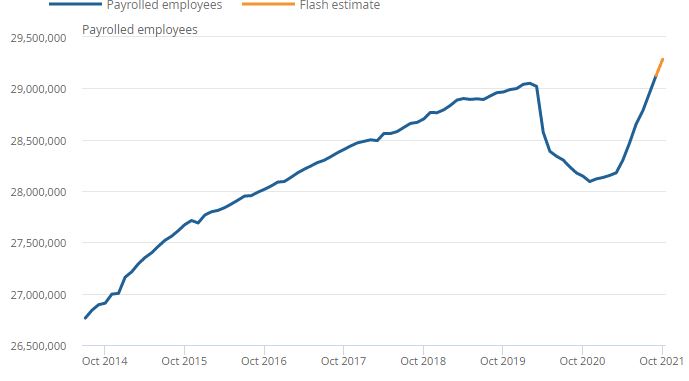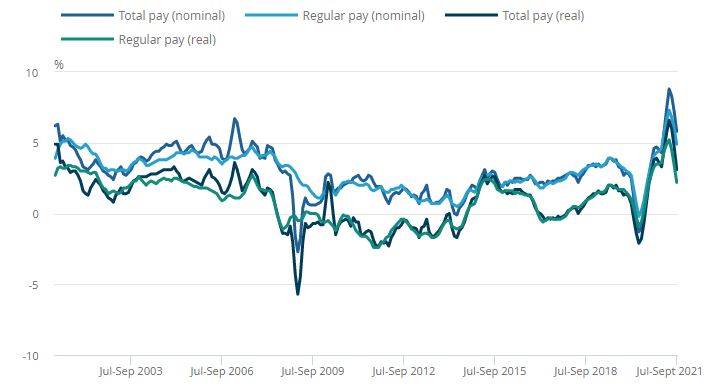ONS Labour Market November 2021
A new record high for vacancies
- The estimated number of vacancies rose to a new record high, with 15 out of 18 industry sectors recording record highs.
- Between August and October, the number of vacancies accelerated to 1,172,000 – some 388,000 above its pre-pandemic January to March 2020 level.
- The largest increase on the quarter was in wholesale and retail trade with repair of motor vehicles and motorcycles growing by 29,600 (24.8%).
Payroll numbers rise
- Early payroll estimates for October show the number of payrolled employees rose by 4.0% year-on-year – or 1,139,000 employees – edging up by 160,000 employees on September 2021.
- All age groups saw an increase in payrolled employees between October 2020 and October 2021.
- Those aged under 25 years old saw an increase of 501,000 payrolled employees.
- The increase in payrolled employees on an annual basis was largest in the administrative and support services sector (up by 283,000 employees) and smallest in the transportation and storage sector (a fall of 14,000).
Payrolled employees, seasonally adjusted, UK, July 2014 to October 2021
Source: HM Revenue and Customs – Pay As You Earn Real Time Information
- On the wider survey measure of employment, the employment rate was still down 1.1 percentage points on pre-pandemic levels at 75.4% in the quarter to September. However, this was a 0.4 percentage point uplift on the previous quarter (April to June 2021).
- The quarterly increase in employment was driven by a record high net flow from unemployment to employment. The rise is also driven by an increase in part-time work and the number of people on zero-hour contracts.
Unemployment falls further
- The latest unemployment estimates show a 0.5 percentage point dip on the previous quarter to 4.3% in the three months to September. This is 0.3 percentage points higher than before the pandemic.
- The quarterly decrease in unemployment continued to be driven by those unemployed for up to 12 months. By comparison, long-term unemployed over a year increased, while those unemployed for less than six months slowed to slightly less than pre-pandemic times.
Hours worked rise
- In the three months to September, total actual weekly hours worked increased by 25.2 million hours from the previous quarter to 1.03 billion hours as Covid restrictions eased.
- However, this is still 2.4% below pre-pandemic levels, or 25.6 million hours.
Earnings climb
- Average regular pay (excluding bonuses) for employees in Great Britain was £544 per week before tax and other deductions from pay – up from £524 per week a year earlier.
- Average total pay (including bonuses) for employees in Great Britain was £584 per week before tax and other deductions from pay – up from £559 per week a year earlier.
- Regular and total pay growth rose by 4.9% and 5.8% respectively in the three months to September compared to a year earlier.
- In real terms (adjusted for inflation), total and regular pay are growing at 3.1% for total pay and 2.2% for regular pay
It should be noted that:
- Annual growth in average employee pay continued to be disrupted by compositional effects from a fall in the number and proportion of lower-paid jobs.
- Additionally, pay growth is being affected by a base effect from weak annual comparisons.
- However, the impact from these temporary factors has weakened compared to previous months.
Great Britain, average weekly earnings annual growth rates, January to March 2001 to July to September 2021
Source: ONS



